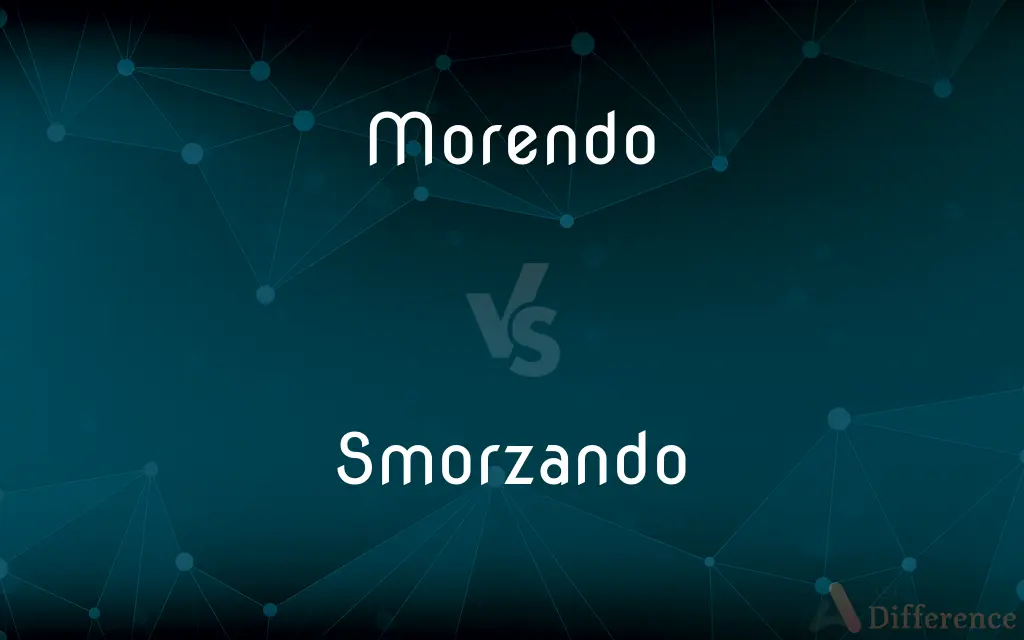Morendo vs. Smorzando — What's the Difference?
By Tayyaba Rehman & Urooj Arif — Updated on April 4, 2024
Morendo means dying away in tone and often in tempo, while smorzando specifically denotes fading away in sound or volume, without implying tempo change.

Difference Between Morendo and Smorzando
Table of Contents
ADVERTISEMENT
Key Differences
Morendo, a musical term, implies a gradual decrease in both volume and often tempo, as if the music is dying away. This effect creates a sense of ending or disappearance, used by composers to convey a fading or dwindling emotion. On the other hand, smorzando focuses primarily on a decrease in sound or volume, with no inherent implication of a tempo change. It's used to instruct musicians to gradually fade the sound until it becomes inaudible, emphasizing a decrease in dynamics rather than a slowing of pace.
While morendo brings a dual effect of softening the sound and potentially slowing the pace, creating a more pronounced feeling of the music coming to an end, smorzando is more about the volume fading to silence. The former can affect the emotional impact of a piece by adding a layer of melancholy or finality through both quieting and slowing. Smorzando, however, primarily alters the dynamic level, leaving the tempo unaffected, which can evoke a sense of distance or softening without the same degree of finality.
In terms of notation, composers may specify morendo (often abbreviated as "moren.") when they want a passage to gradually fade away, possibly becoming slower and quieter until it disappears. In contrast, smorzando (abbreviated as "smorz.") might be used when the intention is to solely decrease the volume of a section, without necessarily altering its speed. This makes smorzando a versatile tool for dynamic variation, enhancing the expressive quality of the music without changing its rhythmic flow.
Musicians interpreting morendo passages need to be sensitive to both the dynamic and tempo nuances, potentially requiring a more comprehensive adjustment in their playing technique to embody the dying effect. Conversely, smorzando requires a focus on gradually reducing the sound level, which can be achieved through various techniques depending on the instrument, such as bow pressure and speed for string instruments, or breath control for wind instruments.
Understanding the context and desired emotional effect is crucial when composers choose between morendo and smorzando. Morendo might be used to conclude a piece or a movement, suggesting a final breath or a conclusive fade into silence. Smorzando could be applied within a piece to diminish the sound of a phrase or section, serving as a dynamic contrast rather than suggesting an end.
ADVERTISEMENT
Comparison Chart
Definition
Decrease in volume and often tempo
Decrease in sound or volume
Implication
Suggests a dying away in both sound and movement
Primarily focuses on fading sound
Tempo Change
Often implies a tempo change
Does not imply a tempo change
Emotional Effect
Conveys a sense of ending or finality
Creates a sense of distance or fading presence
Notation
Abbreviated as "moren."
Abbreviated as "smorz."
Compare with Definitions
Morendo
Gradual decrease in volume and tempo.
The piece concludes with a morendo, evoking a sense of serene finality.
Smorzando
Specifically denotes a decrease in volume.
The violin section enters a smorzando, receding into silence.
Morendo
Often used to end a piece.
The final notes, played morendo, leave a lingering sense of loss.
Smorzando
Used for dynamic variation without tempo change.
The smorzando effect creates a soft transition between movements.
Morendo
Emphasizes a dual fade in music.
Achieving the morendo effect demands precise timing and dynamic adjustment.
Smorzando
Gradual fading of sound or volume.
The smorzando in measure 24 gently diminishes the theme’s intensity.
Morendo
Fading away in both sound and speed.
The morendo passage requires careful control of tempo and dynamics.
Smorzando
Focuses on sound fading to inaudibility.
The smorzando requires subtle control over the instrument’s volume.
Morendo
Signifying a musical dying away.
The composer uses morendo to symbolize the sunset at the piece’s end.
Smorzando
Creates a sense of distance or softening.
Smorzando, the choir’s volume fades, leaving a haunting quiet.
Morendo
(music) Fading away in tone or tempo.
Smorzando
(music) Fading away.
Morendo
Dying; a gradual decrescendo at the end of a strain or cadence.
Smorzando
Growing gradually fainter and softer; dying away; morendo.
Common Curiosities
How does smorzando differ from morendo?
Smorzando specifically refers to fading away in sound or volume, without the implication of tempo change that morendo often carries.
How should musicians approach a morendo passage?
Musicians should carefully adjust both their dynamics and tempo to embody the fading and slowing effect intended by morendo.
Can morendo affect the emotional impact of a piece?
Yes, morendo can significantly affect the emotional impact by conveying finality or a dying away, often evoking melancholy.
Is smorzando used to change the tempo of music?
No, smorzando does not imply a tempo change; it focuses on gradually decreasing the volume.
What does morendo mean in music?
Morendo means a gradual decrease in both volume and often tempo, giving a sense of fading away.
What does smorzando indicate to a performer?
Smorzando indicates to a performer to gradually decrease the sound level until it becomes inaudible, without altering the tempo.
How do notations for morendo and smorzando differ?
Morendo is often notated as "moren." while smorzando is abbreviated as "smorz.", guiding the intended effect on dynamics and tempo.
Can smorzando be used within a musical piece?
Yes, smorzando can be used within a piece to dynamically lower the volume of a phrase or section, serving as a contrast or transition.
What techniques can achieve a smorzando effect?
Techniques vary by instrument but may include reducing bow pressure or speed on strings, or lowering breath pressure on wind instruments.
How important is context in interpreting morendo and smorzando?
Context is vital; understanding the piece’s overall mood and the composer’s intent can guide the execution of morendo and smorzando.
Why might a composer choose morendo over smorzando?
A composer might choose morendo to convey a stronger sense of conclusion or emotional depth, utilizing both dynamic and tempo changes.
What challenges might musicians face with morendo?
The dual requirement to fade in volume while potentially slowing down can challenge musicians to maintain musical coherence and expression.
Is morendo only used at the end of pieces?
While often used to conclude pieces or movements, morendo can also appear within pieces to signal transitions or thematic ends.
What's the emotional significance of smorzando?
Smorzando can create a feeling of distance, softening, or a gentle retreat, adding nuance to the musical expression.
Share Your Discovery

Previous Comparison
Live vs. Living
Next Comparison
Bandana vs. NeckerchiefAuthor Spotlight
Written by
Tayyaba RehmanTayyaba Rehman is a distinguished writer, currently serving as a primary contributor to askdifference.com. As a researcher in semantics and etymology, Tayyaba's passion for the complexity of languages and their distinctions has found a perfect home on the platform. Tayyaba delves into the intricacies of language, distinguishing between commonly confused words and phrases, thereby providing clarity for readers worldwide.
Co-written by
Urooj ArifUrooj is a skilled content writer at Ask Difference, known for her exceptional ability to simplify complex topics into engaging and informative content. With a passion for research and a flair for clear, concise writing, she consistently delivers articles that resonate with our diverse audience.
















































